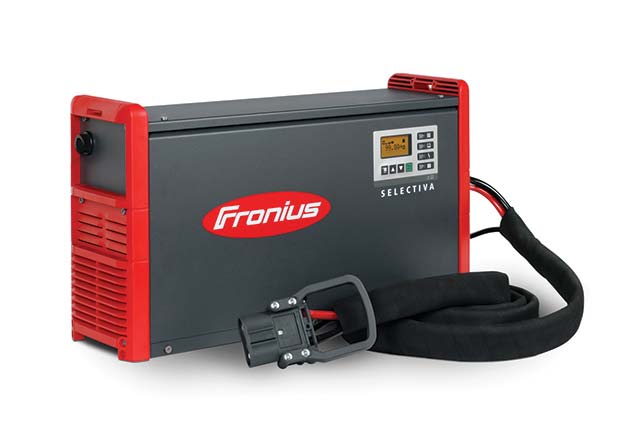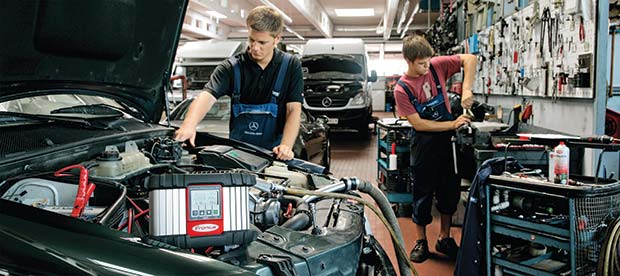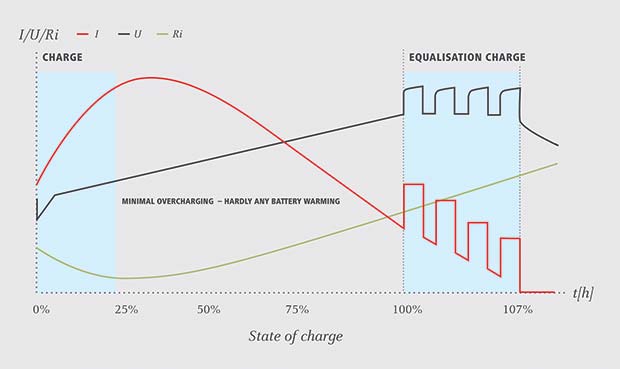Driven by the aim of providing intelligent energy management systems that ensure maximum cost-effectiveness and performance, Fronius have set new standards in energy efficiency and battery service life with their range of battery chargers for intralogistics and have become among the leading suppliers in Europe within this segment. In 2005, Fronius pioneered a technical revolution by combining the benefits of transformer technology with those of efficient inverter technology. The result is the unique, economical and flexible Active Inverter Technology. This year, they set a whole new standard by unveiling the Ri charging process improving efficiency even further.
 Fronius also manufacture intelligent charging systems for vehicle batteries. The Acctiva range of compact starter battery chargers are not only able to withstand the rigours of everyday use, but also make charging much easier. Ross Adams, Sales, Fronius UK, spoke to Warehouse & Logistics News.
Fronius also manufacture intelligent charging systems for vehicle batteries. The Acctiva range of compact starter battery chargers are not only able to withstand the rigours of everyday use, but also make charging much easier. Ross Adams, Sales, Fronius UK, spoke to Warehouse & Logistics News.
WLN – First of all, what does your role involve day to day? Has it changed since last year?
Day to day I work closely with our distributors IBCS and Powercell, providing key service and sales support for them, also visiting their customers and prospect customers promoting the Fronius brand. We also work with end users directly in the intralogistic market where we can see that a bespoke Fronius battery charging system can provide them with energy and cost saving solutions.
As well as our range of traction battery chargers, we also have a portfolio of products for the automotive industry. We provide fail-safe battery charging systems for workshops and showrooms of some of Europe’s leading car manufacturers.
Customers of Fronius battery charging systems have previously had to deal directly with Fronius International in Austria. I am pleased to say that over the last eighteen months we have been able to provide increasing support from the UK, from sales and marketing extending to some service support.
WLN – How was it for you?
Upon joining Fronius at the end of 2012 after working for a leading forklift truck manufacturer, my main focus was to work with our distributors, building a strong relationship with their respective sales teams using my knowledge of the materials handling industry. In turn 2013 has been very successful, seeing an increase in sales. Early in the year we launched our new, unique 8kW and 16kW ‘Ri – Selectiva range’ which contributed to a good year, whilst we continued to build on the success of our 1kW and 3kW range. We now plan to expand the Battery Charging Systems division of Fronius for 2014.
WLN – How has the Power Sources category been performing this year? What do you see as the most significant recent developments?
During times when intralogistics represents a growing cost factor in many businesses, with energy costs accounting for a large proportion of the overall costs, a trend towards greater efficiency is increasingly apparent. Fronius have reacted to this this by releasing new technology designed to reduce the costs associated with battery charging.
WLN – How are your existing products and services doing? Have you developed or upgraded your existing products and services recently?
As well as the Selectiva range of battery chargers, Fronius have successfully implemented an emission-free and efficient logistics operation within their site in Sattledt, Austria. The “HyLOG” Fleet is a number of logistic trains used to transport materials to more than 600 workplaces using a portable hydrogen-powered PEM fuel cell instead of conventional lead/acid batteries.
This is a totally regenerative energy supply and storage system that cuts the need for several hours of battery charging, doubles the energy density of conventional batteries and also doubles the vehicle range.
The hydrogen used for the HyLOG Fleet is produced by Fronius in-house via an electrolysis process powered by a 615 kWp PV system on the roof. The hydrogen is then stored and made available for refueling via an in-house filling station infrastructure. The fuel cell integrated into the vehicle then converts the hydrogen into energy to operate the vehicle.
This year the technology has been extended to the premises of DB Shenker – one of the world’s leading integrated transport and logistics providers. The project provides ten warehouse trucks with the Fronius Energy Cell. Hydrogen gas is generated at high efficiency by on-site reforming, compression and storage of bio-methane – an environmentally sound and zero greenhouse gas emission fuel. This refueling takes place indoors, making it the first indoor filling station for hydrogen in Europe.

WLN – Have you launched any new products or services, and how are they performing?
We launched the new Selectiva 8kW and 16kW models in the UK at IMHX this year. These replace the 7kW and 14kW models and use a completely new and unique way of charging medium and large traction or forklift truck batteries. The new features of the chargers bring major advantages to the user as well as huge environmental benefits.
 WLN – What are those benefits?
WLN – What are those benefits?
In addition to a much longer service life, one of the most impressive features of the new Ri-charging process is its maximum energy efficiency. The new generation of Selectiva chargers achieve charging efficiency levels that were previously inconceivable – a staggering 90%. As a result, there is a massive reduction in CO2, and battery service life is maximized. This all contributes to the reduction in the total cost of ownership. What’s more, the chargers have reduced not only in size, but significantly in weight, with the larger variant (80v with 180A) now only 30Kg down from 40Kg.
WLN – Can you describe the difference between the Ri-charging process and other chargers that use HF and 50Hz technology?
The Ri-charging process is a self-regulating process which allows the charging characteristic to be adapted according to the type of battery, age, temperature and discharge level – all of which are continually monitored. Every charging cycle is therefore a one-off. The charging current is adapted automatically during charging which keeps charge losses to a minimum due to the low power requirement, thus a saving in energy and only insignificant warming of the battery.
For companies with fluctuating forklift truck utilization levels, harmful overcharging is prevented, ensuring batteries are not damaged. Furthermore, peak currents which drive up costs are prevented in situations where the charging of a number of forklift truck batteries takes place simultaneously at the end of a shift.
The old 50 Hertz transformer technology charges the battery without considering its present state at all, resulting in excessive overcharging and high energy costs. In the case of high-frequency technology, the battery is charged with the current held constant, which reduces the damaging battery warming and as a consequence, the service life compared with 50 Hertz transformer technology is increased. Both technologies work on the same principle, however. They charge on the basis of a predefined, fixed charging characteristic and almost totally ignore the state of the battery.
You can find out more about how the technology works and the advantages of it by watching our product animations on our YouTube channel, “FroniusCharging.”

WLN – What’s been your company’s single biggest achievement in business this year?
Working together with our main distributors, we have achieved a significant increase in sales due to increased awareness of our products and brand, the success of our new generation of Selectiva chargers with the Ri-Charging process, and with a little bit of advertising in Warehouse and Logistics News!
WLN – Do you operate in any other countries besides the UK? Have you gone into any new territories recently?
Fronius UK Ltd is a subsidiary of Fronius International GmbH based in Austria where all our manufacturing takes place. Currently there are Fronius subsidiaries in 20 countries throughout the world, with the most recent opening in India this year.
WLN – Are you exhibiting at any major trade shows in 2014?
Yes, you can see us at CeMAT, Hannover in May 2014.

WLN – Why do some logistics managers choose the old 50Hz chargers when they have so many disadvantages?
The charger is often overlooked in the purchasing decision when buying logistics systems. Decisions are based on the specifications of the forklift itself and not the battery or the charger, when actually the charger plays a major role in determining ongoing operating costs. The charger has a major influence over electricity costs, the level of CO2 emissions and the total service life of the battery. Fronius can provide a battery lifecycle costs calculation completely free of charge showing the potential savings in terms of energy costs and CO2 emissions that you could obtain by using Fronius battery chargers. You can fill in our online I-SpoT form at our website www.fronius.com/intralogistics
WLN – What other headline news from Fronius can our readers look forward to reading about in Warehouse & Logistics News next year?
Watch out for developments surrounding the introduction of complete Fronius battery charging stations for intralogistics.
Readers can also expect to read about new innovations within our battery charging systems.
Phone: 01908 512300
Email: Info-uk@fronius.com
Web: www.fronius.com/intralogistics
Youtube: FroniusCharging




Comments are closed.